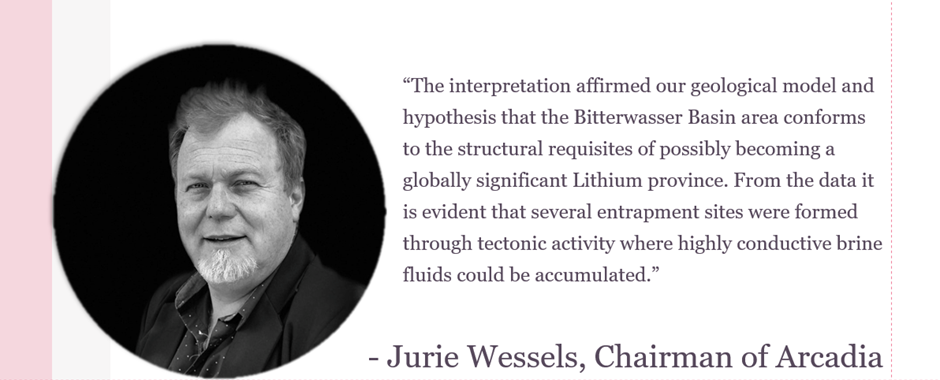Highlights
- Arcadia Minerals has announced a geophysical interpretation of the helicopter borne electro-magnetic survey that was concluded recently by the company geologists at its Bitterwasser project.
- As per the interpretation, there is structural concurrence between highly anomalous electro-magnetic zones and mineralised lithium clay pans.
- AM7 has defined three potentially lithium-rich brine sub-basins at Bitterwasser.
- The company is planning for three stratigraphic boreholes by March 2023 to support exploration.
Diversified exploration company Arcadia Minerals Ltd (ASX:AM7 FRA: 8OH) has announced a geophysical interpretation of the helicopter borne electro-magnetic (EM) survey that was concluded recently across its Bitterwasser project.
An interpretation has been undertaken using both government magnetic data purchased from the Ministry of Mines and Energy of Namibia and the company’s recent helicopter EM survey.
As per the interpretation of government magnetic data purchased from the Ministry of Mines and Energy of Namibia, there is indication for the presence of three major north-south trending faults which are counted responsible for developing the Bitterwasser half graben structure.
Key details of the geophysical interpretation
The en-echelon faults or tension fractures indicated in the interpretation are related to the large north-south trending fault structures. It is being considered that the north-east southwest trending fault in the southern portion of the magnetic image triggered an up-lift of the basement basalt. As a result, the barrier for the creation of the Bitterwasser basin was formed thereby creating a closed basin and trapping water flow from the north and acting like a dam wall.
Also, the company has highlighted that there is a distinct concurrence between structures observed from EM data and the formation of mineralised lithium clay pans.

Data source: company update
Understanding the survey data
The interpretation of both the magnetic and electro-magnetic data reflects a correlation between the anomalies derived from the electro-magnetic data and structural features derived from the magnetic data.
As per the Electro-Magnetic survey, there is potential of an inflow of brine fluids from the north, which is in line with the hypothesis of the firm that the Bitterwasser Pans were mineralised due to the effect of evaporative concentration of salts and the concentration of lithium in the pans through a fluctuating brine water table.
Also, a highly conductive layer is indicated between 100m to 200m depth in the electro-magnetic cross sections. The results also show a concurrence between a brine anomaly under the Eden pan and the Madube Pan.
The publicly available geological data suggests that the main drainage area in the north holds igneous and volcanic rocks, including rhyolitic ignimbrites, rock fragments, volcanic ash, and tuffs which were chemically weathered and deposited in the Bitterwasser basin. The company expects that known geothermal fluids related to the identified fault structures and recirculated underlying magma will lead to salt (brine) and potentially lithium enrichment before deposition into these closed basins. This supports the geological model designed by Arcadia Minerals.
Notably, these geological models and features are similar to that of the Clayton Valley Lithium deposit in Nevada, USA, and in the Andean region of South America, also known as the Lithium Triangle, highlights the company update.

Data source: company update
On the whole, the Bitterwasser area is being considered perfect for brines as the closed drainage basin has thick sands and gravels from the Kalahari formation. Both the pans at Eden and Madube basins hold high lithium contents with a basement depth of around 120 m below surface.
Management commentary

Data source: Company update; Image source: © 2023 Krish Capital Pty. Ltd.
Arcadia Minerals plans to drill three stratigraphic holes by March 2023 to verify the geophysical results, to increase its geological understanding of the Bitterwasser basin and to obtain valuable information regarding the sediments associated within the basin. These will aid the company to embark on a targeted brine-borehole drilling programme.
“Although not the objective, it is not excluded that stratigraphic drilling could lead to the discovery of a significant brine deposit at Bitterwasser,” Wessels added.
AM7 shares traded at AU$0.245 on 8 February 2023, up more than 6.5% from the last close, with a market capitalisation of AU$19.66 million.




